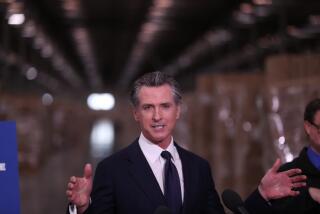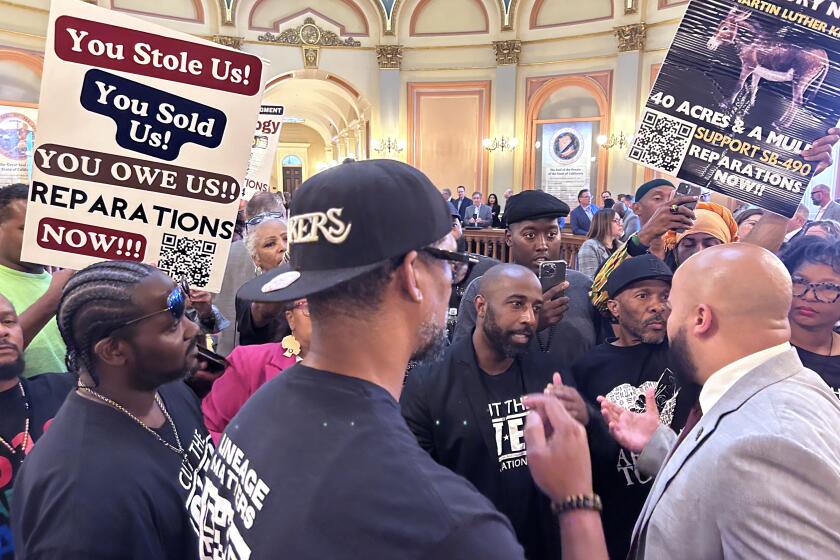Column: Gov. Newsom’s California Health Corps to fight coronavirus is unprecedented. Now he needs to produce

- Share via
SACRAMENTO — It’s easy for political leaders to order people to stay home and cover their faces when they venture out. What’s hard is to make all those ambitious programs work that they’re launching.
Gov. Gavin Newsom and Los Angeles Mayor Eric Garcetti have earned kudos for briefing the public almost daily on their latest steps to fight the highly contagious coronavirus.
Newsom was the first governor in the nation to issue a stay-at-home order for people not engaged in essential services, such as providing healthcare, bagging groceries or operating gas stations. Garcetti was the first mayor to ask people to wear homemade masks when out and about.
But that’s just verbal jabber mixed with persuasion and cheerleading.
Making all the programs work that they’re rolling out — many in partnership with private enterprise — will be the final test of their performances during this pandemic crisis.
For example, there’s Newsom’s unprecedented California Health Corps program. It’s an effort to build up a reserve army of backup doctors, nurses and other medical care specialists who can be called up to replace frontline providers when they get overwhelmed by surging caseloads or become sick themselves.
Newsom is leading an effort to add 50,000 hospital beds to the 75,000 already existing in California, and his Health Corps volunteers will help staff the extra beds. They’ll be paid.
“We need you,” Newsom exclaimed, sounding like Uncle Sam in one of those iconic World War II recruiting posters.
His appeal was aimed at trained medical providers who may be just short of qualifying for their licenses or perhaps have changed careers or recently retired.
The governor is hoping for a 37,000-person corps. And within the first 24 hours there were 25,000 applications.
“I’m overwhelmed,” he told reporters, praising the “remarkable spirit [of] people who have stepped up…. That was extraordinary…. I’m inspired.”
Within 72 hours, 75,000 people had applied.
Great! But is the state government capable of swiftly vetting that many people to make sure they’re truly qualified to treat virus patients? How many really can be counted on to help control the surge when it strikes in a few weeks or even days?
I’m skeptical, having watched state government move at a snail’s pace over the years, regardless of who’s governor. Newsom will need to be hands-on and insistent.
“What’s the alternative?” asks state Sen. Richard Pan (D-Sacramento), a pediatrician. “If [recruits] need a little brushing up, they can learn on the job.
“In a war when you’re out of reserves, you’re really in trouble. You tend to lose the battle.”
Assemblyman Jim Wood (D-Healdsburg) is a dentist who has volunteered in several disasters — including California wildfires — identifying bodies through dental records. He’s worried that Newsom’s Health Corps will ship recruits out of their rural hometowns into big cities, leaving their own isolated counties strapped.
“Are there going to be resources for rural regions or is it all going to be sucked into large urban areas?” Wood asks. “One of my counties, Mendocino, has one public health director and one public health nurse. And it’s two hours from one end of the county to the other. What happens when rural and urban counties have outbreaks at the same time?”
Rural patients lose.
One irresponsible state move on March 30 was to flash the OK sign for overcrowded hospitals to send virus-infected patients to nursing homes —called “skilled nursing facilities.” There are more than 1,000 of them in California, filled with fragile people considered the most vulnerable to the coronavirus because they’re mainly elderly with medical ailments.
Nursing homes have been fighting their own battle against the pandemic and largely losing.
But the state Department of Public Health issued an order that skilled nursing facilities “shall not refuse to admit or readmit a resident based on their status as a suspected or confirmed COVID-19 case.”
Hello! “Nursing home” means “home.” I can’t imagine a state public health official allowing a virus-infected stranger to bed down in his or her home.
Outraged nursing home advocates shouted that the state was prescribing death sentences for residents.
The state public health department backed down a bit on Thursday, saying that nursing homes could refuse infected patients if the facilities weren’t stocked with necessary personal protective equipment such as masks and gloves. And, in any case, the patient transfers must be coordinated with local health departments.
Nursing home advocates weren’t satisfied. And for Newsom to escape an angry mob of seniors and their grown children, he’ll need to make sure that no virus-infected patients are shoved into already disease-stricken nursing homes.
Meanwhile, testing for the coronavirus has been a bust in California and most everywhere in the country. Results often take agonizing days to show up. As of Thursday, there was a backlog of 59,000 unprocessed tests, the governor said.
But on Saturday Newsom reported some hopeful news. The backlog was down to 13,000 out of nearly 127,000 tests.
Testing “has been challenging…and I own that,” the governor said. “I have a responsibility…to do better and do more testing.”
Most important, Newsom announced that Stanford University was about to secure federal approval for a test that could determine whether someone had developed protective antibodies — immunity — that could fight off the coronavirus.
Presumably an immune person could escape house arrest and return to work.
Newsom and other political leaders deserve credit for trying. Now they need to produce.
More to Read
Sign up for Essential California
The most important California stories and recommendations in your inbox every morning.
You may occasionally receive promotional content from the Los Angeles Times.











